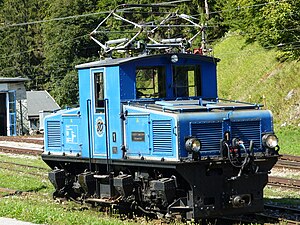BZB No. 1 to 4 (locomotive)
| Valley locomotives 1 to 4 | |
|---|---|
| Numbering: | 1 to 4 |
| Number: | 4th |
| Year of construction (s): | 1929 |
| Axis formula : | Bo |
| Gauge : | 1000 mm ( meter gauge ) |
| Length over coupling: | 6,900 mm |
| Height: | 2,600 mm |
| Fixed wheelbase: | 3,200 mm |
| Service mass: | 27.5 tons |
| Top speed: | 50 km / h |
| Hourly output : | 224 kW (at 20 km / h) |
| Continuous output : | 148 kW (at 22.5 km / h) |
| Driving wheel diameter: | 1,200 mm |
| Power system : | 1650 V DC |
| Power transmission: | Overhead line |
| Number of traction motors: | 2 |
| Drive: | Paw camp |
| Translation levels: | 6.06: 1 |
| Brake: | Vacuum brake |
| Train heating: | electric |
| Coupling type: | Scharfenberg coupling |
The valley locomotives 1 to 4 of the Bayerische Zugspitzbahn were meter gauge electric locomotives for pure adhesion operation, which were supplied by MAN and AEG. They were procured together with the mountain locomotives 11 to 18 as initial equipment for the Bavarian Zugspitzbahn.
history
With the opening of the valley line between Garmisch-Partenkirchen and Grainau , the Bayerische Zugspitzbahn acquired four electric locomotives for adhesion operation. The two-axle valley locomotives for the valley route between Garmisch-Partenkirchen and Grainau with the serial numbers 4268 to 4271 had the task of transporting a maximum of six passenger cars from Garmisch-Partenkirchen to Grainau at up to 40 km / h. With a second locomotive as a leader , up to seven passenger cars could be pulled.
The locomotives handled all traffic on the valley line until the double multiple units 10 and 11 were put into operation in 1987 . As a result, locomotive No. 2 was decommissioned in 1988 and erected as a memorial in Garmisch-Partenkirchen at the intersection of St. Martin-Strasse and Olympiastrasse, near Garmisch train station ( former location ) . In 2003 it was renovated and then moved to the Garmisch-Partenkirchner Rathausplatz ( Lage ) , where it is still located. Locomotive No. 3 was in operation until 2008 and since then has stood together with the mountain locomotive No. 11 as a memorial in front of the traffic center of the German Museum on Schwanthalerhöhe in Munich ( Lage ) . Locomotives No. 1 and No. 4 are still in operation and are used for special trains, for shunting work in Grainau station and in winter for clearing snow on the valley line.
technology
Mechanical part
The frame is designed as a sheet metal frame made of 30 mm thick steel plates and as an outer frame. The centrally located, closed driver's cab is connected to two low front structures in which the equipment is housed. The hoods can be removed for maintenance work. The locomotive is driven by two traction motors that are designed in a pawl bearing design. The drive wheel diameter was chosen to be unusually large in order to ensure sufficient ground clearance in rails equipped with racks. The locomotives are braked with an automatic vacuum brake , the Hardy system, and a hand spindle brake as a parking brake. A two-cylinder piston vacuum pump is installed in the locomotives to generate the vacuum for the vacuum brake. The pump is driven by a DC motor with mains voltage. An additional compressor generates compressed air to operate the compressed air whistle, the compressed air bell and the sand spreader . A distance-dependent safety driving circuit acts on the suction air brake in order to be able to operate the locomotives without an assistant . The safety driving control is operated either by a foot control on the driving switch or by one of the two hand buttons on the entrance doors by the train driver.
For winter service , a snow plow is attached to one of the locomotives in the direction of Garmisch-Partenkirchen in order to clear the route from Grainau to Garmisch-Partenkirchen.
Electrical part
On the roof of the driver's cab there is a pantograph which can be raised by means of a spring and lowered by a hand-operated pulley. To divert overvoltages, a horn spark gap and an aluminum arrester are installed between the pantograph and the main switch . The locomotives have seven starting resistors for starting . The two four-pole traction motors are always connected in series. With two additional field weakening levels , the locomotive had a total of three continuous speed levels. To control the locomotive, a high -voltage drive switch is installed in the middle of the driver's cab , with which the speed levels can be set directly.
Web links
Individual evidence
- ↑ a b Erich Preuss: The Bavarian Zugspitzbahn . transpress, 1997, ISBN 3-613-71054-4 .
- ↑ Gerd Wolf: German small and private railways . tape 7 . EK-Verlag, 2002, ISBN 3-88255-666-8 , Bayerische Zugspitzbahn AG (BZB), p. 185-208 .
- ↑ Locomotive is moving soon. Mercury, June 18, 2003, accessed June 17, 2020 .
- ^ Bernhard Weidemann: Historic locomotives of the Zugspitzbahn in the German Museum. Deutsches Museum, April 2, 2008, accessed June 17, 2020 .
- ↑ Bayerische Zugspitzbahn Bergbahn AG (Ed.): Data & Technology . January 2019 ( zugspitze.de ).
- ↑ a b The Bavarian Zugspitzbahn . In: AEG (Ed.): Messages . Issue 4, April 1931, ISSN 0374-2423 , Lokomotiven, p. 250-261 .
- ↑ a b The locomotives of the Bavarian Zugspitzbahn . In: The Locomotive . XXIX. Volume, Issue 1, January 1932, p. 3 ff . ( onb.ac.at ).


